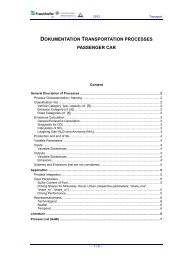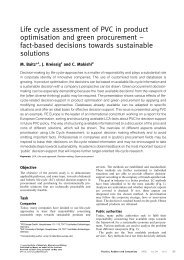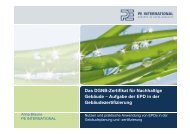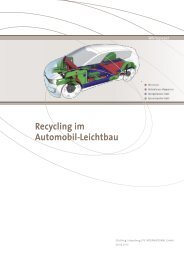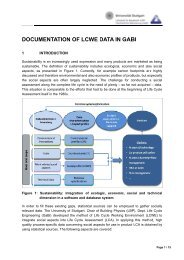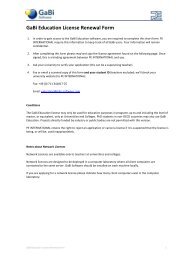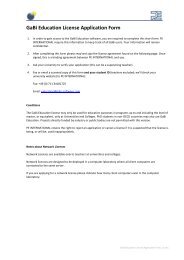GaBi Education - GaBi Software
GaBi Education - GaBi Software
GaBi Education - GaBi Software
You also want an ePaper? Increase the reach of your titles
YUMPU automatically turns print PDFs into web optimized ePapers that Google loves.
Conducting Life Cycle Assessments<br />
one year, or, the CO2-equivalents of one person in Western Europe per year. When the<br />
results of all impact categories are compared to their references, they can be compared to<br />
each other more easily, since it is possible to say which impact indicator result contributes<br />
more or less to the overall entity of this impact category.<br />
Figure 11 shows impact categories normalized for different regions.<br />
3.0E-11<br />
2.5E-11<br />
2.0E-11<br />
1.5E-11<br />
1.0E-11<br />
5.0E-12<br />
0.0E+00<br />
GWP 100<br />
Year [-]<br />
ODP [-] AP [-] EP [-] POCP [-]<br />
Figure 11: Normalized impact categories for different regions<br />
23<br />
USA<br />
North America<br />
World<br />
Normalized impact indicator results are non-dimensional quantities that allow for<br />
comparison between different impact categories; which impact category has a normal<br />
amount and which one is relatively larger? The normalized results of all chosen impact<br />
categories can also be displayed in a single graph, since they do not have different<br />
physical units anymore.<br />
2.3.5.2 Grouping<br />
Grouping involves the sorting and ranking of the impact categories. It is an optional<br />
element with two possible approaches. The impact categories could be sorted on a<br />
nominal basis by characteristics such as inputs and outputs or global, regional or local<br />
spatial scales. The impact categories could also be ranked in a given hierarchy, for<br />
example in high, medium, and low priority. Ranking is based on value-choices. Different<br />
individuals, organizations, and societies may have different preferences. It is therefore<br />
possible that different parties will reach different ranking results based on the same<br />
indicator results or normalized indicator results.<br />
2.3.5.3 Weighting<br />
Weighting is an optional element of the LCA and is based on value-choices and not on<br />
scientific principles. Weighting is used to compare different impact indicator results<br />
according to their significance. This weighting of the significance of an impact category is<br />
expressed with weighting factors. Those weighting factors are appraised through surveys<br />
among different groups (for example experts with hierarchical, egalitarian or individual<br />
approach, population…).Weighting can also be used to aggregate weighted impact<br />
indicator results to a single score result.



